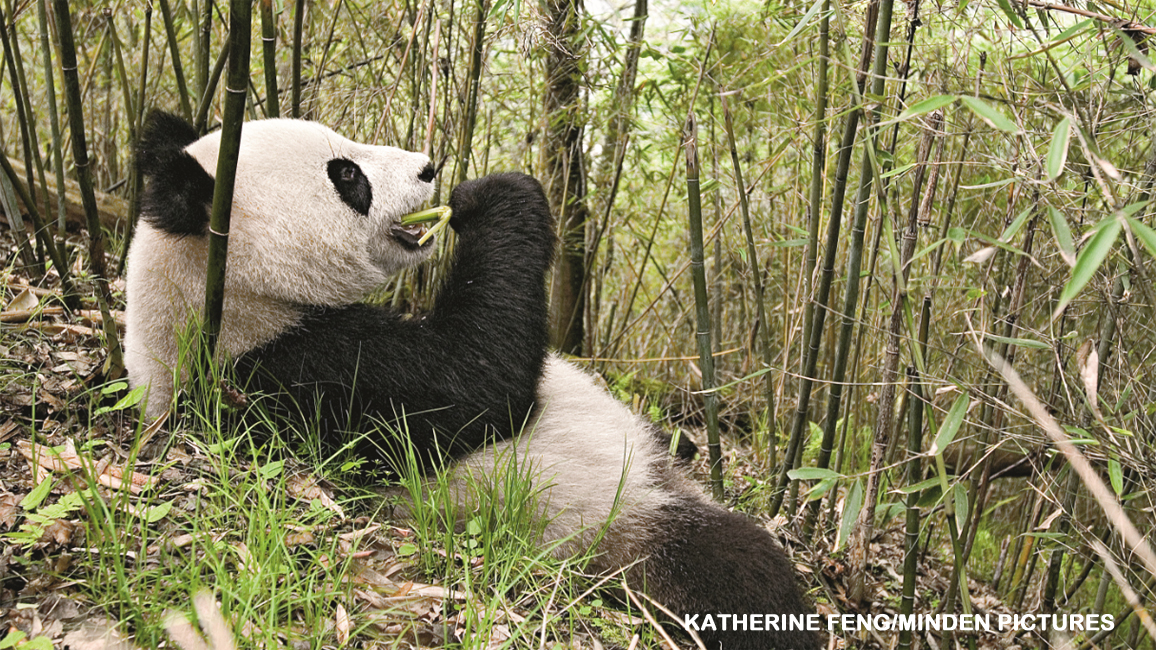
The Bear Necessities
By Kathy KrankingA bear is a bear is a bear, right? Not quite!

It’s true that all bears have certain things in common, such as furry bodies, huge claws, short tails, and long snouts with a great sense of smell. Also, most of them are omnivores (AHM-nuhvorz), which means they’ll eat both plants and animals.
But bear species also have differences from each other, whether it’s how they look, where they live, or what their very favorite foods are. There’s no such thing as an average bear!
STAND TALL
A grizzly bear, also called brown bear, is one of the biggest bears. When one stands up on its hind legs like this, it can be twice as tall as you are! Bears sometimes stand to pick up a scent or get a better look at something.
You may have seen photos of grizzly bears feasting on salmon in rivers. Fish is a favorite of grizzlies, but there are lots of other things on their menu, too. They’ll eat everything from plants to small mammals to insects!

BIG EATER
A giant panda is easy to recognize. With its black-and-white fur, it looks very different from other bears.
If a panda made a to-do list, it would look a lot like this: Eat bamboo. Sleep. Eat more bamboo. Bamboo grows in the panda’s mountain forest home and is the bear’s main food. To get enough nutrition from bamboo, a panda needs to spend 10 to 16 hours a day eating it. The bear’s back teeth are flat to crush the plant’s leaves, shoots, and stems.
NAME GAME
The name sloth bear might confuse you. Is the animal a sloth? Is it a bear? Turns out, it’s all bear. But when it was first discovered, a scientist thought it was related to a sloth because it has shaggy fur and long claws and sometimes hangs out in trees.
But a sloth bear isn’t anything like a slow-moving, sleepy sloth. It spends a lot of time busily—and noisily—searching for and eating food. A sloth bear’s year-round favorite meal is insects, especially termites, and the bear is built for eating them. Its claws are perfect for digging into termite mounds. And it has a gap between its two front teeth, so it can slurp up termites without teeth getting in the way.
Unlike other bear moms, a sloth bear mom carries her young on her back most of the time. The babies cling to an extra-shaggy “saddle” of fur that grows there. There’s nothing like a “beary-back” ride!

COZY IN THE COLD
A polar bear is right at home in a world of ice and snow. It can keep warm in temperatures as low as 30 degrees below zero! Under a polar bear’s skin is a super-thick layer of fat. It’s like a built-in blanket that holds in heat. The polar bear also has two layers of fur: an outer layer of long hairs and a thick undercoat.
A polar bear stays warm in icy water, too. It’s a good swimmer that can paddle for miles. This snow-white bear hunts for food both in the ocean and on the ice. Its favorite meal? A plump seal!
TALENTED TONGUE
The sun bear is the world’s smallest bear. If it stood up, it would be only a little taller than you are. Probably the most interesting thing about the sun bear is its 10-inchlong tongue. It’s a handy tool for lapping up one of the bear’s favorite foods: honey. First it rips open a tree to get to a bee nest. Then it uses its super-long tongue to reach the honey inside. Maybe its name should be “honey bear”!
SLEEPY TIME
Can you imagine taking a nap in the branches of a tree? This black bear finds it perfectly comfy. It even uses a branch as a pillow! As its name says, a black bear is usually black. But some may come in other colors, such as brown, cinnamon, blonde, gray, or even white. Black bears aren’t just good at climbing. They’re also good swimmers and can run pretty fast. And when it comes to food, they aren’t picky at all. They’ll eat anything, from plants and insects to fish and mammals.
And that’s the end of this look at some not-so-average bears!

















